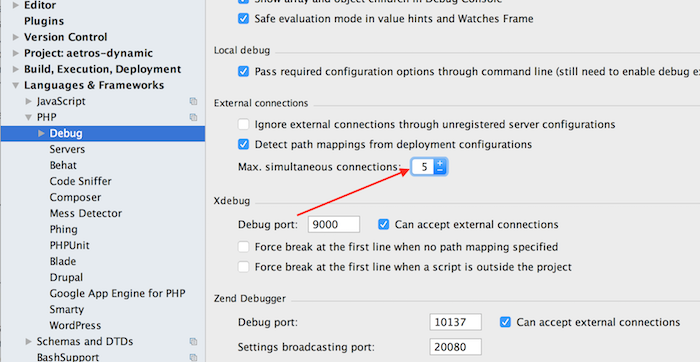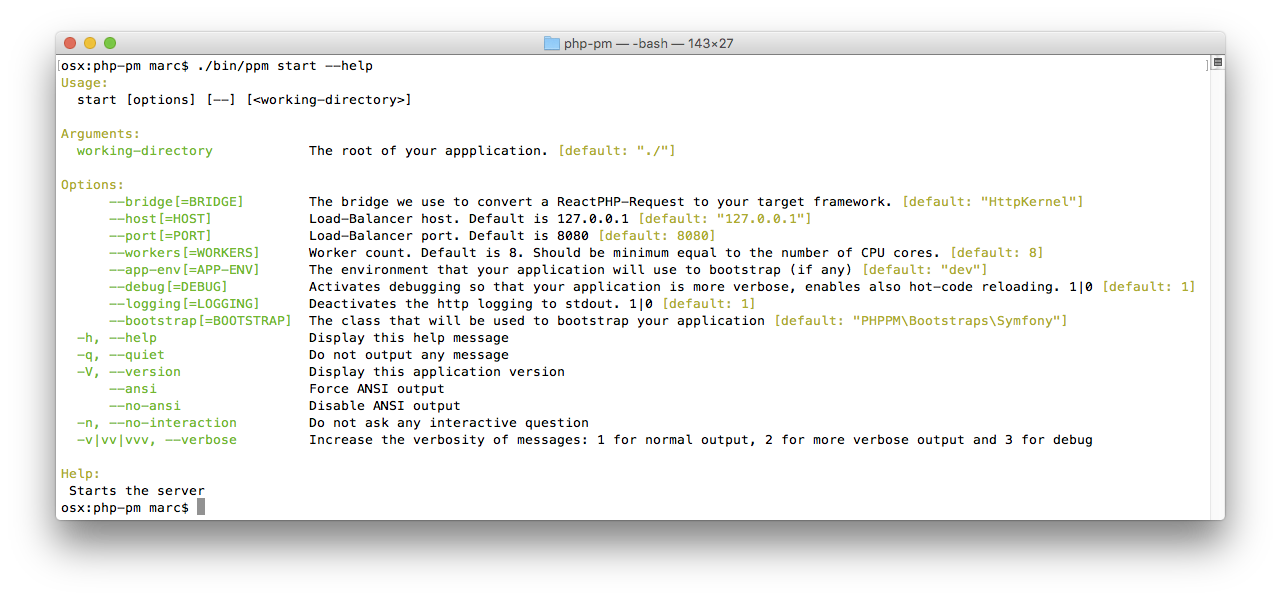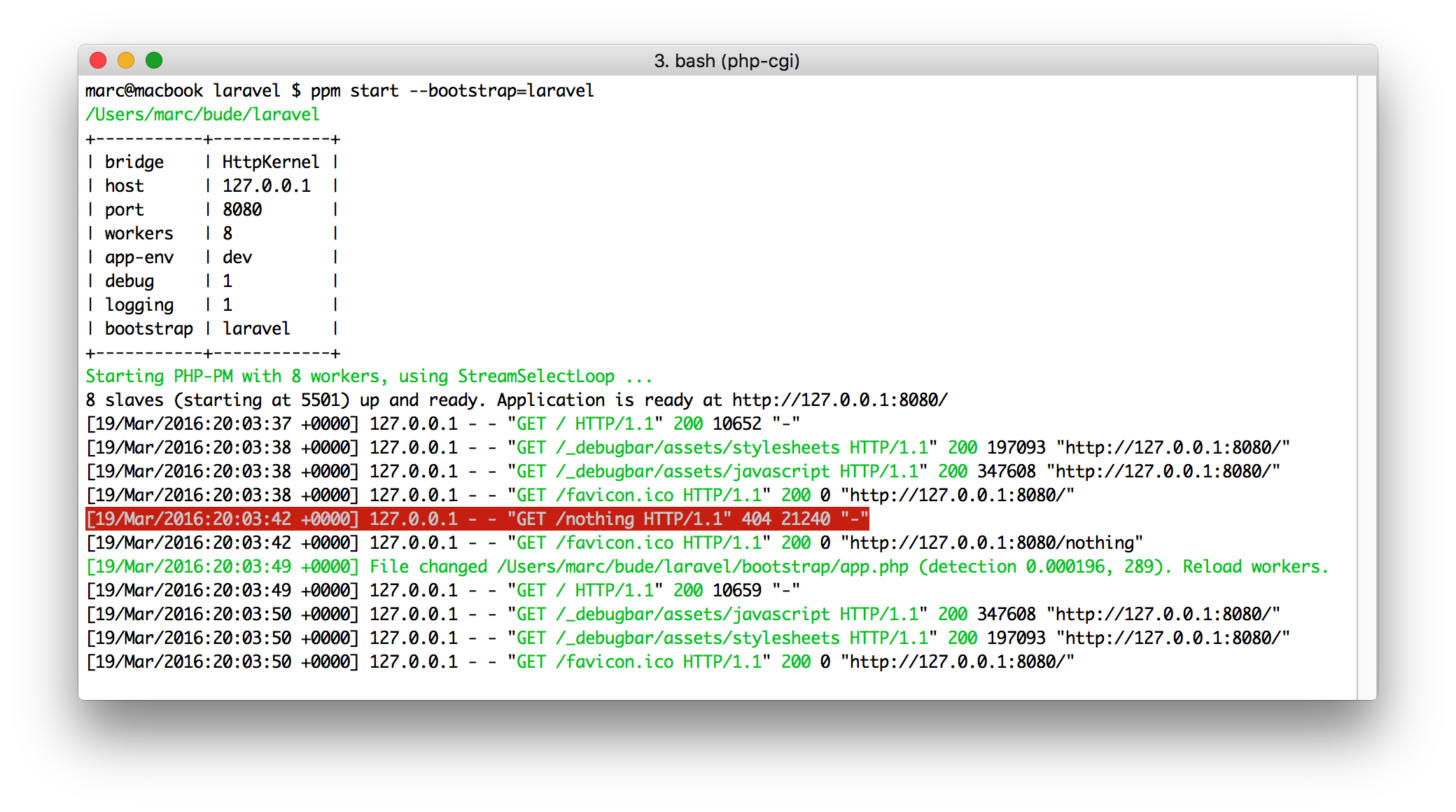PPM - PHP Process Manager
Adapted for Re-action framework
 , (*1)
, (*1)
PHP-PM is a process manager, supercharger and load balancer for PHP applications., (*2)

 , (*3)
, (*3)
It's based on ReactPHP and works best with applications that use request-response frameworks like Symfony's HTTPKernel.
The approach of this is to kill the expensive bootstrap of PHP (declaring symbols, loading/parsing files) and the bootstrap of feature-rich frameworks. See Performance section for a quick hint.
PHP-PM basically spawns several PHP instances as worker bootstraping your application (eg. the whole Symfony Kernel) and hold it in the memory to be prepared for every
incoming request: This is why PHP-PM makes your application so fast., (*4)
More information can be found in the article: Bring High Performance Into Your PHP App (with ReactPHP), (*5)
Features
- Performance boost up to 15x (compared to PHP-FPM, Symfony applications).
- Integrated load balancer.
- Hot-Code reload (when PHP files change).
- Static file serving for easy development procedures.
- Support for HttpKernel (Symfony/Laravel), Drupal (experimental), Zend (experimental).
Badge all the things
Does your app/library support PPM? Show it!, (*6)
 , (*7)
, (*7)
[](https://github.com/php-pm/php-pm)
Use
cd into/your-application
# run Symfony
docker run -v `pwd`:/var/www -p 8080:80 phppm/nginx --bootstrap=symfony --static-directory=web/
# run Laravel
docker run -v `pwd`:/var/www -p 8080:80 phppm/nginx --bootstrap=laravel --static-directory=public/
Docker is easier to setup and maintain. If your applications requires additional environment tools or libraries,
you can build your own image based on ours. See github.com/php-pm/php-pm-docker for more information., (*8)
When debug is enabled, PHP-PM detects file changes and restarts its worker automatically., (*9)
Use without Docker
Follow the wiki article Use without Docker., (*10)
To get the maximum performance you should usually use --app-env=prod with disabled
debug --debug=0. Also make sure xdebug is disabled. Try with different amount of workers.
Usually a 10% over your cpu core count is good. Example: If you have 8 real cores (excl. hyper-threading) use --workers=9., (*11)
To get even more performance (for static file serving or for rather fast applications) try a different event loop (see https://github.com/reactphp/event-loop)., (*12)
Debugging
If you get strange issues in your application and you have no idea where they are coming from try
using only one worker --workers=1 and enable -v or -vv., (*13)
When debugging you should use xdebug as you're used to. If you set a break point and hold the application, then only one
worker is stopped until you release the break point. All other workers are fully functional., (*14)
Note for XDebug and PHPStorm: Since php-pm uses at least two processes, there are two xdebug instances as well. PHPStorm is per default configured to only accept one connection at a time. You need to increase that. You won't get xdebug working with your application if you don't increase that count., (*15)
 , (*16)
, (*16)
In all workers the STDOUT is redirected to the connected client. So take care, var_dump, echo are not displayed on the console.
STDERR is not redirected to the client, but to the console. So, for very simple debugging you could use error_log('hi') and you'll see it on the console.
Per default exceptions and errors are only displayed on the console, prettified with Symfony/Debug component., (*17)
Adapter
HttpKernel for Symfony/Laravel - https://github.com/php-pm/php-pm-httpkernel, (*18)
Zend - https://github.com/php-pm/php-pm-zend, (*19)
CakePHP - https://github.com/CakeDC/cakephp-phppm, (*20)
Command
 , (*21)
, (*21)
 , (*22)
, (*22)
Symfony
cd my-project
docker run -v `pwd`:/var/www -p 8080:80 phppm/nginx --static-directory=web/
Laravel
cd my-project
docker run -v `pwd`:/var/www -p 8080:80 phppm/nginx --bootstrap=laravel --static-directory=web/
Zend
cd my-project
docker run -v `pwd`:/var/www -p 8080:80 phppm/nginx --bootstrap=Zf2
Wordpress
For all Wordpress lovers out there: PPM is not going to work with Wordpress due to the lack of request-response abstraction.
We highly doubt that Wordpress is ever going to be compatible because its architecture is written in a way that makes it
currently impossible to serve multiple requests in one application process., (*23)
6x4GHz Intel i7, 16GB RAM. 10 concurrent, 1000 total request: ab -c 10 -n 1000 http://127.0.0.1:8080/, (*24)
Symfony, CMS application
ppm start --bootstrap=symfony --app-env=prod --logging=0 --debug=0 --workers=20, (*25)
https://github.com/jarves/jarves, (*26)
| PHP Version |
Dynamic at Jarves |
Static file |
| 7.0.3, StreamSelectLoop |
2387,67 |
3944,52 |
| 5.6.18, StreamSelectLoop |
1663,56 |
2636,09 |
| 5.6.18, LibEventLoop |
1811,76 |
3441,72 |
Laravel, example package
https://github.com/bestmomo/laravel5-example, (*27)
ppm start --bootstrap=laravel --app-env=prod --debug=0 --logging=0 --workers=20, (*28)
 , (*29)
, (*29)
Issues
- Memory leaks, memory leaks and memory leaks. You will also find leaks in your application. :) But no big issue since workers restart automatically.
- Does not work with ExtEventLoop. (So don't install
php70-event, but you can try LibEventLoop php56-libevent)
- Drupal and Zend is very experimental and not fully working. Try using https://github.com/php-pm/php-pm-drupal.
- Laravel's debugger isn't working perfectly yet since it's still needed to reset some stuff after each request.
- Streamed responses are not streamed yet
- No windows support due to signal handling
Please help us fix these issues by creating pull requests. :), (*30)
Setup
We provide ready-to-use docker images you can use right away.
If you have own setup, see in the PHP-PM docker repository how to integrate PHP-PM in your NGiNX setup., (*31)
Trusted proxy Symfony
To get the real remote IP in your Symfony application for example, don't forget to add ppm (default 127.0.0.1)
as trusted reverse proxy., (*32)
# app/config/config.yml
# ...
framework:
trusted_proxies: [127.0.0.1]
More information at http://symfony.com/doc/current/cookbook/request/load_balancer_reverse_proxy.html., (*33)
 Wallogit.com
Wallogit.com

 , (*16)
, (*16) , (*21)
, (*21) , (*22)
, (*22) , (*29)
, (*29)